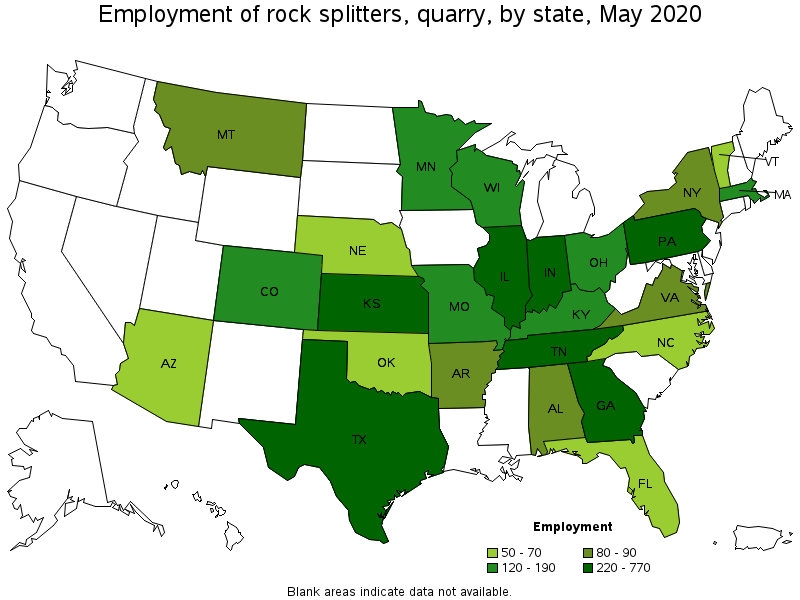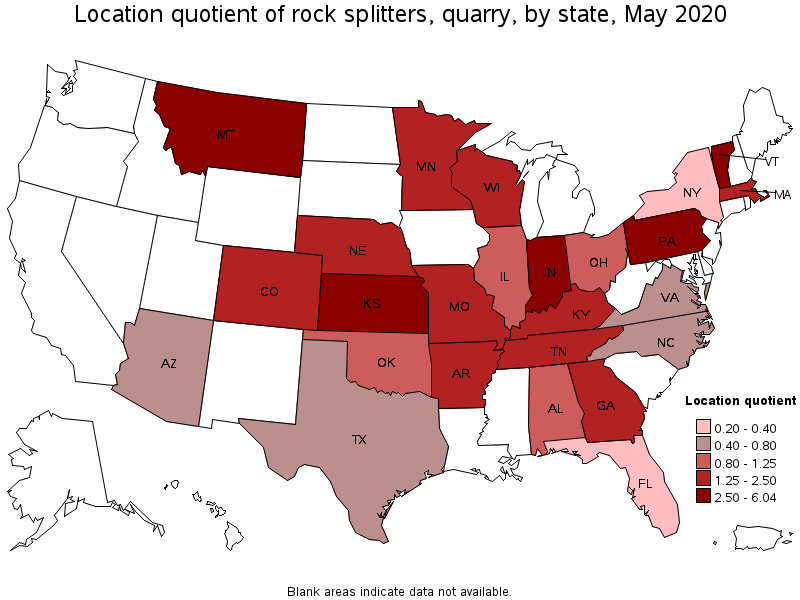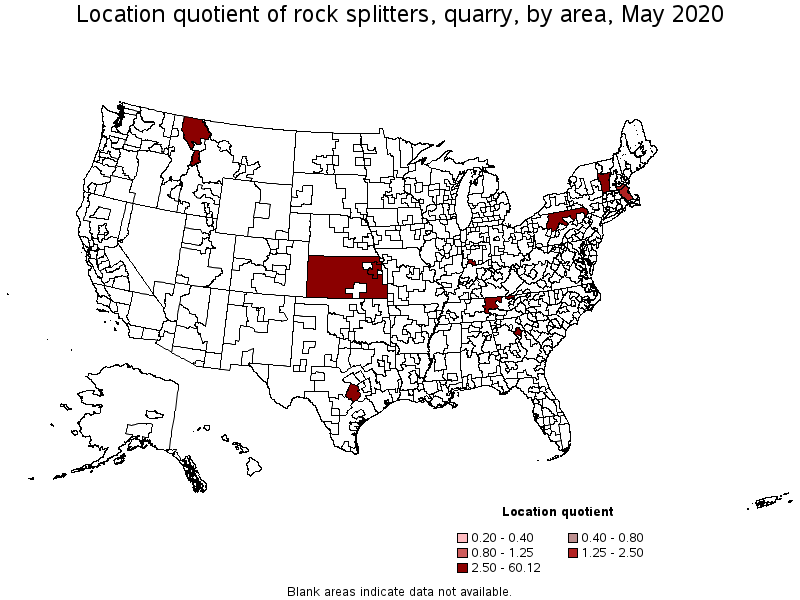An official website of the United States government
 United States Department of Labor
United States Department of Labor
Separate blocks of rough dimension stone from quarry mass using jackhammers, wedges, or chop saws.
Employment estimate and mean wage estimates for Rock Splitters, Quarry:
| Employment (1) | Employment RSE (3) |
Mean hourly wage |
Mean annual wage (2) |
Wage RSE (3) |
|---|---|---|---|---|
| 4,640 | 8.2 % | $ 18.48 | $ 38,430 | 1.2 % |
Percentile wage estimates for Rock Splitters, Quarry:
| Percentile | 10% | 25% | 50% (Median) |
75% | 90% |
|---|---|---|---|---|---|
| Hourly Wage | $ 13.28 | $ 15.37 | $ 17.85 | $ 21.02 | $ 24.87 |
| Annual Wage (2) | $ 27,620 | $ 31,980 | $ 37,130 | $ 43,730 | $ 51,730 |
Industries with the highest published employment and wages for Rock Splitters, Quarry are provided. For a list of all industries with employment in Rock Splitters, Quarry, see the Create Customized Tables function.
Industries with the highest levels of employment in Rock Splitters, Quarry:
| Industry | Employment (1) | Percent of industry employment | Hourly mean wage | Annual mean wage (2) |
|---|---|---|---|---|
| Nonmetallic Mineral Mining and Quarrying | 3,990 | 4.05 | $ 18.30 | $ 38,060 |
| Nonmetallic Mineral Product Manufacturing | 430 | 0.11 | $ 20.50 | $ 42,650 |
| Employment Services | 30 | 0.00 | $ 19.95 | $ 41,510 |
Industries with the highest concentration of employment in Rock Splitters, Quarry:
| Industry | Employment (1) | Percent of industry employment | Hourly mean wage | Annual mean wage (2) |
|---|---|---|---|---|
| Nonmetallic Mineral Mining and Quarrying | 3,990 | 4.05 | $ 18.30 | $ 38,060 |
| Nonmetallic Mineral Product Manufacturing | 430 | 0.11 | $ 20.50 | $ 42,650 |
| Employment Services | 30 | 0.00 | $ 19.95 | $ 41,510 |
Top paying industries for Rock Splitters, Quarry:
| Industry | Employment (1) | Percent of industry employment | Hourly mean wage | Annual mean wage (2) |
|---|---|---|---|---|
| Nonmetallic Mineral Product Manufacturing | 430 | 0.11 | $ 20.50 | $ 42,650 |
| Employment Services | 30 | (7) | $ 19.95 | $ 41,510 |
| Nonmetallic Mineral Mining and Quarrying | 3,990 | 4.05 | $ 18.30 | $ 38,060 |
States and areas with the highest published employment, location quotients, and wages for Rock Splitters, Quarry are provided. For a list of all areas with employment in Rock Splitters, Quarry, see the Create Customized Tables function.

States with the highest employment level in Rock Splitters, Quarry:
| State | Employment (1) | Employment per thousand jobs | Location quotient (9) | Hourly mean wage | Annual mean wage (2) |
|---|---|---|---|---|---|
| Pennsylvania | 770 | 0.14 | 4.20 | $ 18.28 | $ 38,020 |
| Indiana | 340 | 0.11 | 3.44 | $ 18.49 | $ 38,450 |
| Georgia | 250 | 0.06 | 1.72 | $ 18.69 | $ 38,880 |
| Kansas | 230 | 0.17 | 5.17 | $ 19.09 | $ 39,710 |
| Tennessee | 220 | 0.08 | 2.28 | $ 18.70 | $ 38,900 |

States with the highest concentration of jobs and location quotients in Rock Splitters, Quarry:
| State | Employment (1) | Employment per thousand jobs | Location quotient (9) | Hourly mean wage | Annual mean wage (2) |
|---|---|---|---|---|---|
| Montana | 90 | 0.20 | 6.04 | $ 17.03 | $ 35,430 |
| Kansas | 230 | 0.17 | 5.17 | $ 19.09 | $ 39,710 |
| Vermont | 50 | 0.16 | 4.88 | $ 15.54 | $ 32,330 |
| Pennsylvania | 770 | 0.14 | 4.20 | $ 18.28 | $ 38,020 |
| Indiana | 340 | 0.11 | 3.44 | $ 18.49 | $ 38,450 |

Top paying states for Rock Splitters, Quarry:
| State | Employment (1) | Employment per thousand jobs | Location quotient (9) | Hourly mean wage | Annual mean wage (2) |
|---|---|---|---|---|---|
| Nebraska | 60 | 0.07 | 1.98 | $ 26.97 | $ 56,100 |
| California | (8) | (8) | (8) | $ 24.04 | $ 50,010 |
| Kentucky | 120 | 0.07 | 2.08 | $ 21.61 | $ 44,950 |
| Massachusetts | 160 | 0.05 | 1.41 | $ 21.50 | $ 44,720 |
| Maryland | (8) | (8) | (8) | $ 21.23 | $ 44,170 |

Metropolitan areas with the highest employment level in Rock Splitters, Quarry:
| Metropolitan area | Employment (1) | Employment per thousand jobs | Location quotient (9) | Hourly mean wage | Annual mean wage (2) |
|---|---|---|---|---|---|
| Austin-Round Rock, TX | 130 | 0.13 | 3.83 | $ 15.06 | $ 31,330 |
| Topeka, KS | 120 | 1.19 | 35.62 | $ 18.64 | $ 38,770 |
| Boston-Cambridge-Nashua, MA-NH | 120 | 0.05 | 1.43 | $ 20.16 | $ 41,940 |
| Athens-Clarke County, GA | 80 | 0.98 | 29.29 | $ 18.44 | $ 38,360 |
| Bloomington, IN | 80 | 1.12 | 33.65 | $ 19.94 | $ 41,470 |

Metropolitan areas with the highest concentration of jobs and location quotients in Rock Splitters, Quarry:
| Metropolitan area | Employment (1) | Employment per thousand jobs | Location quotient (9) | Hourly mean wage | Annual mean wage (2) |
|---|---|---|---|---|---|
| Topeka, KS | 120 | 1.19 | 35.62 | $ 18.64 | $ 38,770 |
| Bloomington, IN | 80 | 1.12 | 33.65 | $ 19.94 | $ 41,470 |
| Athens-Clarke County, GA | 80 | 0.98 | 29.29 | $ 18.44 | $ 38,360 |
| Austin-Round Rock, TX | 130 | 0.13 | 3.83 | $ 15.06 | $ 31,330 |
| Boston-Cambridge-Nashua, MA-NH | 120 | 0.05 | 1.43 | $ 20.16 | $ 41,940 |

Top paying metropolitan areas for Rock Splitters, Quarry:
| Metropolitan area | Employment (1) | Employment per thousand jobs | Location quotient (9) | Hourly mean wage | Annual mean wage (2) |
|---|---|---|---|---|---|
| Boston-Cambridge-Nashua, MA-NH | 120 | 0.05 | 1.43 | $ 20.16 | $ 41,940 |
| Washington-Arlington-Alexandria, DC-VA-MD-WV | (8) | (8) | (8) | $ 19.94 | $ 41,480 |
| Bloomington, IN | 80 | 1.12 | 33.65 | $ 19.94 | $ 41,470 |
| Pittsburgh, PA | (8) | (8) | (8) | $ 19.51 | $ 40,590 |
| Reading, PA | (8) | (8) | (8) | $ 19.46 | $ 40,480 |
| Fort Collins, CO | (8) | (8) | (8) | $ 19.04 | $ 39,600 |
| Nashville-Davidson--Murfreesboro--Franklin, TN | (8) | (8) | (8) | $ 18.97 | $ 39,450 |
| Topeka, KS | 120 | 1.19 | 35.62 | $ 18.64 | $ 38,770 |
| Athens-Clarke County, GA | 80 | 0.98 | 29.29 | $ 18.44 | $ 38,360 |
| New York-Newark-Jersey City, NY-NJ-PA | (8) | (8) | (8) | $ 17.04 | $ 35,450 |
Nonmetropolitan areas with the highest employment in Rock Splitters, Quarry:
| Nonmetropolitan area | Employment (1) | Employment per thousand jobs | Location quotient (9) | Hourly mean wage | Annual mean wage (2) |
|---|---|---|---|---|---|
| Northern Pennsylvania nonmetropolitan area | 290 | 2.01 | 60.12 | $ 17.40 | $ 36,200 |
| Kansas nonmetropolitan area | 100 | 0.26 | 7.66 | $ 19.81 | $ 41,200 |
| West Montana nonmetropolitan area | 90 | 1.23 | 36.83 | $ 17.03 | $ 35,430 |
| North Central Tennessee nonmetropolitan area | 60 | 0.53 | 15.75 | $ 18.75 | $ 39,010 |
| Southern Vermont nonmetropolitan area | 50 | 0.47 | 14.10 | $ 15.54 | $ 32,330 |
Nonmetropolitan areas with the highest concentration of jobs and location quotients in Rock Splitters, Quarry:
| Nonmetropolitan area | Employment (1) | Employment per thousand jobs | Location quotient (9) | Hourly mean wage | Annual mean wage (2) |
|---|---|---|---|---|---|
| Northern Pennsylvania nonmetropolitan area | 290 | 2.01 | 60.12 | $ 17.40 | $ 36,200 |
| West Montana nonmetropolitan area | 90 | 1.23 | 36.83 | $ 17.03 | $ 35,430 |
| North Central Tennessee nonmetropolitan area | 60 | 0.53 | 15.75 | $ 18.75 | $ 39,010 |
| Southern Vermont nonmetropolitan area | 50 | 0.47 | 14.10 | $ 15.54 | $ 32,330 |
| Kansas nonmetropolitan area | 100 | 0.26 | 7.66 | $ 19.81 | $ 41,200 |
Top paying nonmetropolitan areas for Rock Splitters, Quarry:
| Nonmetropolitan area | Employment (1) | Employment per thousand jobs | Location quotient (9) | Hourly mean wage | Annual mean wage (2) |
|---|---|---|---|---|---|
| Kansas nonmetropolitan area | 100 | 0.26 | 7.66 | $ 19.81 | $ 41,200 |
| North Central Tennessee nonmetropolitan area | 60 | 0.53 | 15.75 | $ 18.75 | $ 39,010 |
| Southern Pennsylvania nonmetropolitan area | (8) | (8) | (8) | $ 18.41 | $ 38,300 |
| Northern Pennsylvania nonmetropolitan area | 290 | 2.01 | 60.12 | $ 17.40 | $ 36,200 |
| West Montana nonmetropolitan area | 90 | 1.23 | 36.83 | $ 17.03 | $ 35,430 |
These estimates are calculated with data collected from employers in all industry sectors, all metropolitan and nonmetropolitan areas, and all states and the District of Columbia. The top employment and wage figures are provided above. The complete list is available in the downloadable XLS files.
The percentile wage estimate is the value of a wage below which a certain percent of workers fall. The median wage is the 50th percentile wage estimate—50 percent of workers earn less than the median and 50 percent of workers earn more than the median. More about percentile wages.
(1) Estimates for detailed occupations do not sum to the totals because the totals include occupations not shown separately. Estimates do not include self-employed workers.
(2) Annual wages have been calculated by multiplying the hourly mean wage by a "year-round, full-time" hours figure of 2,080 hours; for those occupations where there is not an hourly wage published, the annual wage has been directly calculated from the reported survey data.
(3) The relative standard error (RSE) is a measure of the reliability of a survey statistic. The smaller the relative standard error, the more precise the estimate.
(7) The value is less than .005 percent of industry employment.
(8) Estimate not released.
(9) The location quotient is the ratio of the area concentration of occupational employment to the national average concentration. A location quotient greater than one indicates the occupation has a higher share of employment than average, and a location quotient less than one indicates the occupation is less prevalent in the area than average.
Other OEWS estimates and related information:
May 2020 National Occupational Employment and Wage Estimates
May 2020 State Occupational Employment and Wage Estimates
May 2020 Metropolitan and Nonmetropolitan Area Occupational Employment and Wage Estimates
May 2020 National Industry-Specific Occupational Employment and Wage Estimates
Last Modified Date: March 31, 2021